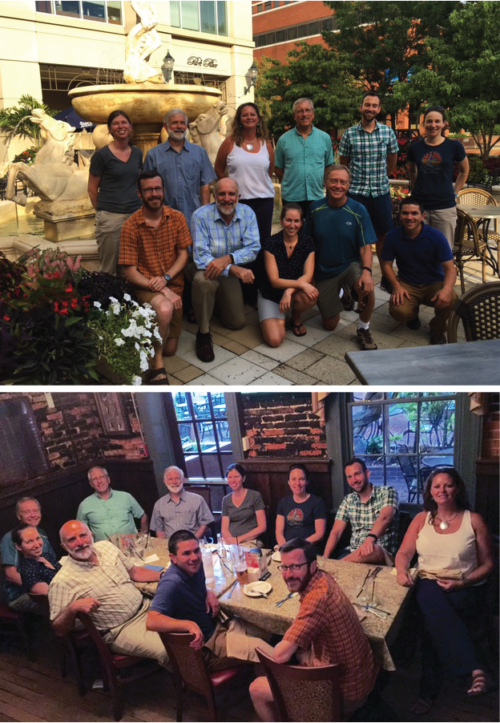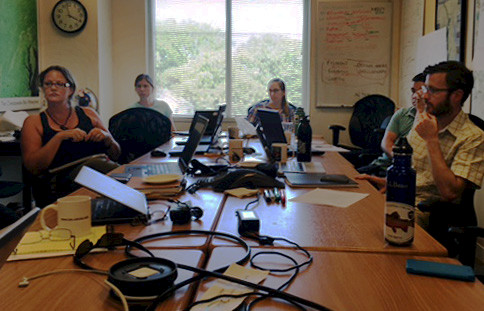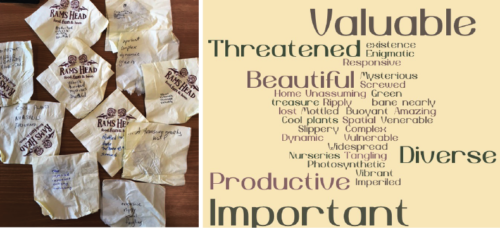Developing scientific stories for Chesapeake Bay submerged aquatic vegetation
Bill Dennison ·The submerged aquatic vegetation (SAV) can be used as sentinels for the health of Chesapeake Bay. A working group of scientists has been formed to analyze three decades of water quality data and annual surveys of submerged aquatic vegetation. Bob Orth, a researcher based at the Virginia Institute of Marine Science (VIMS), and I are leading this effort.

Twenty five years ago, Bob Orth, Ken Moore and I collaborated with several other Chesapeake scientists to establish the relationship of water quality and SAV, resulting in a Bioscience paper published in 1993 entitled "Assessing water quality with submerged aquatic vegetation". But there is much more data available now and we need new tools and approaches to analyze these data. So along with senior scientists Don Weller from the Smithsonian Environmental Research Center and Ken Moore from VIMS, we have recruited a cadre of bright young scientists to complement our long years of experience. These young scientists who can analyze large, complex data sets are the following: Cassie Gurbisz, National Socio-Environmental Synthesis Center; Mike Hannam, SERC; Jeni Keisman, USGS; Brooke Landry, Maryland Department of Natural Resources; Jon Lefcheck, VIMS; Rebecca Murphy, UMCES; Chris Patrick, Texas A&M Corpus Christi; Jeremy Testa, UMCES, Dave Wilcox, VIMS. We have coined this effort "SAV SYN", short for Submerged Aquatic Vegetation Synthesis.

Bob Orth and I co-chaired a global seagrass trajectories synthesis effort at the National Center for Ecological Analysis and Synthesis (NCEAS). We saw the utility of conducting a similar synthesis effort, targeted for Chesapeake Bay. But we were unable to obtain support from the Chesapeake Bay Program for a synthesis effort. So Bob and I initiated our own synthesis effort with several colleagues, which resulted in a 2010 publication in the journal Estuaries and Coasts entitled "Long term trends in submerged aquatic vegetation (SAV) in Chesapeake Bay, USA, related to water quality". We are grateful that Rich Batiuk, Associate Director for Science, Analysis and Implementation, Chesapeake Bay Program, has initiated the current SAV SYN effort. The concept of conducting Chesapeake Bay synthesis efforts, supported by the Chesapeake Bay Program, was developed when a large group of Chesapeake scientists involved in a Monitoring Realignment Action Team in 2009 recognized that the comprehensive, high quality data generated in the monitoring program was ripe for good synthesis efforts. After a long gestation period for this concept to become reality, we are now underway.
We hosted the initial SAV SYN working group meeting at the UMCES Annapolis Office, when we were co-located with SESYNC in July, 2016. The second meeting was hosted by Jeremy Testa in the new Truitt Building, Chesapeake Biological Laboratory, in Solomons Island, Maryland in September, 2016. In January, 2017, we will be the first group to use the new UMCES Annapolis Office in Eastport.


A goal of our effort is to tell compelling stories about Chesapeake Bay by using powerful narratives and high quality visualizations. One of the stories we are telling is SAV as "coastal canaries", alluding to their sensitivity to changes in water quality, adjacent land use and shoreline conditions. Coal miners would take canaries with them into the mines, and when the canary would become stressed, the miners knew it was time to take immediate action. Similarly, when SAV are suffering, we argue that we need to take immediate action. The visualizations we have begun producing help tell the Chesapeake SAV story.

We have submitted two papers for publication and will be scoping out additional papers at our next workshop. But the audience for these papers is our peer scientists, which is an important, yet insufficient audience. Thus, we plan to develop some briefing materials and science communication products aimed at broader audiences, including resource managers and students.
About the author
Bill Dennison

Dr. Bill Dennison is a Professor of Marine Science and Vice President for Science Application at the University of Maryland Center for Environmental Science.

